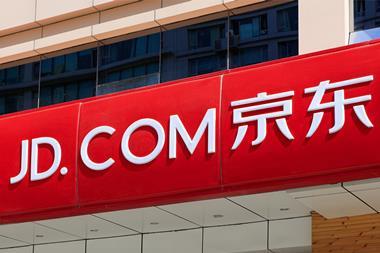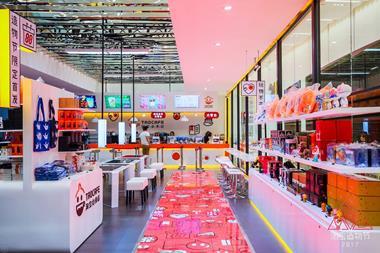Chinese online retail giant JD.com is plotting the biggest store expansion in retail history. Retail Week looks into why and how.
This year, the etailer has pledged to open 1,000 JD.com-branded stores every day – yes, every day – in its native China.
When major retailers hit the expansion trail, they tend to be more conservative, and opening 100 stores a year is seen as ambitious.
In China, however, things are done a little differently.
“Our target is to open 1,000 stores every day by year-end”
Richard Liu, JD.com
At an industry conference in Chongqing last week, JD.com chief executive Richard Liu talked about the group’s franchised Jingdong Convenience Store programme, first unveiled two years ago.
The scheme was progressing very well, he said. The first batch of 1,111 stores simultaneously opened for business on November 2 last year. A strong start, but Liu had even bigger plans in mind.
“As of last month, JD.com opened 1,000 convenience stores in China every week,” he told his audience. “Our target is to open 1,000 stores every day by year-end.”
The system is a franchise model, where operators own their stores, but pay a monthly fee to access specialist training, branding and JD Logistics-supplied products.
One million store target
The scale of JD’s c-store expansion project is unprecedented in its ambition. In April last year, JD set itself the goal of having one million Chinese locations under its banner by 2022.
If Liu manages to stay in-line with his target, a further 250,000 stores will operate under the etailer’s umbrella by January 2019.
And JD.com is not the only ecommerce giant vowing to transform the country’s small-box scene.
Fierce rival Alibaba has had a similar programme (called Lingshoutong Retail Sourcing, or LST) in place since last September. As of November 2017, 50,000 independent traders had signed up to join the scheme.
“China’s vast hinterland boasts an independent sector estimated to comprise six million merchants”
Both operators are driven by the size of the prize. China’s vast hinterland boasts an independent sector estimated to comprise six million merchants. Most of these are family-run, ‘mom-and-pop’ businesses dotted across the country’s countless rural towns and villages.
JD.com and Alibaba believe they can radically transform these businesses. Scruffy, run-down premises are given clean, modern upgrades; the quality of goods is improved and merchants can use the etailers’ data analytics services to better target local catchments.
Small wonder, then, that would-be franchisees are flocking to join up. “We receive 50,000 applications every day,” Liu says. “Applicants are mostly migrant workers returning to their home villages or small towns.”
JD believes its logistics superiority will help it win the battle to dominate the franchise sector. Unlike Alibaba, which only recently took full control of its Cainiao distribution network, JD Logistics owns a nationwide chain capable of supplying this immense future network.
There are obvious gains for the franchisors. Ecommerce platforms like JD.com and Alibaba’s Tmall and Taobao can add millions of new pick-up points for products bought on their website, plus points of sale for add-ons like finance services, such as money transfers and loans, and food delivery, one of China’s fastest-growing sectors.
Small-box retail will dominate Chinese grocery
Planet Retail believes that small-box formats will dominate Chinese grocery retail going forward. Physical shelf space will be scarce for consumer packaged goods in the long run, challenging suppliers to create physical touchpoints and visibility for consumers in the mass market.
While urbanisation continues to proceed at a rapid pace, hitting 76% in 2050, up from 57% today, JD’s model reflects the fact that Chinese cities don’t necessarily offer appropriate working opportunities for the numerous migrants seeking to live there.
In stark contrast to the emerging market modernisation story some years ago, the transformation of China’s independent sector shows how small players will not necessarily fall victim to the retail modernisation process in China, but be an integral part of it.
JD’s and Alibaba’s initiatives benefit the Chinese government’s strive to drive the development and modernisation of China’s vast hinterlands.
This provides an opportunity for consumer packaged goods to reach consumers that would otherwise be unaddressable to them in the world’s largest food market. To take this opportunity, suppliers must develop the digital capabilities required to work with Alibaba and JD.com.
Could the West follow suit?
Viewed from the UK, this may feel like another world, but this is not necessarily the case. Shopper demands are changing across Western societies, with convenience and proximity fast becoming top of consumers’ minds.
Tesco’s acquisition of Booker and, with it, its vast small store network, may well herald a similar transformation of our independent sector.

Tesco’s expertise in ranging, merchandising and digital integration could help a local Londis or Budgens deliver a far more advanced shopping experience than at present.
Many local stores, for instance, often rely on instinct when considering what items to stock. Proper range planning backed up by applied shopper data might help them optimise their assortment to capture top-up shoppers going to and from work.
Close study of a local catchment could better predict what in-store services will best resonate with shoppers.
While no-one is predicting that Tesco boss Dave Lewis will attempt to open 1,000 stores a day, local is clearly already big in Britain: just ask the Co-op.
As the sector grows, so will demand for a better-quality shopping experience. The win is there for a UK operator willing to seize the opportunity, even if that is somewhat smaller than that in China.


























1 Reader's comment